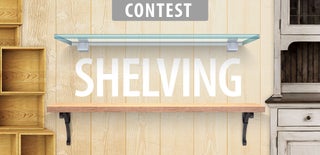Introduction: Coffee/Tea Pallet Drink Station
Previously, we've shown you how to deconstruct a pallet, in this post we share an idea of what to make with those pallet boards. It's important to point out that working with pallets is not for those who like right angles and nice straight edges--pallet lumber is definitely neither, but that is what people like about it. Pallets are usually free, pretty plentiful, and offer up a good amount of usable lumber. Embrace the imperfections that come along with using pallet wood.
If pallet wood is not your thing, then feel free to substitute purchased lumber in the same approximate size. Finish it with a weathered affect and you've got the rustic look without the imprecision!
Step 1: Watch the Video
Step 2: Gather Materials
Materials:
- Pallet wood cut to 36" lengths (enough pieces to create a rectangle approximately 36" X 24")
- MDF board (Home Depot)
- 5 mason jars (we used pint size, wide mouth jars) (Amazon)
- 5 large hose clamps (Amazon)
- Package of six cup hooks (Home Depot)
- French Cleat (Amazon)
- Wood glue
- RapidFuse (Amazon)
- Screws
- Paint--grey and brown for the pallet, black for the screws
Tools:
- Drill
- Impact Driver/bits
- Glue Gun
- Sandpaper
- Orbital Sander
- 1 3/4" Hole Saw
- Clamps
Step 3: Cut Holes for K-cup Shelf
Part of the coffee/tea station will be a place to store K-cups. Clamp one of the pallet boards and a scrap piece of wood and secure it to your workbench with clamps.
Using a 1 3/4" hole saw, make 12 holes approximately 3" apart. Drill part way through on the first pass, flip the board over and finish up the holes.
Step 4: Cut and Paint MDF Board
We purchased a small piece of MDF but we still needed to cut it to size (22x34"). Tip: Ask when you're at Home Depot to have the cuts made.
Because of the imprecision of pallet wood, we knew that some of the MDF might show through, so we painted the board with a combination of gray and brown before attaching the pallet wood.
Step 5: Glue and Secure Everything in Place
Once everything was dry, we started glueing with wood glue the boards into place, starting with the bottom two in which the K-cup holder was sandwiched between.
We used Rapid Fuse to glue the K-cup holder into place.
These three boards were clamped and allowed to dry a few hours.
The remaining boards were glued and clamped into place and allowed to dry overnight.
Step 6: Attach Hooks for Cups
The hooks were positioned across the top. We hot glued them in place just to hold them temporarily and then screwed them into place.
We were unable to find screws that were already black so we used craft paint to camouflage the screw heads.
Step 7: Attach Hose Clamps and Mason Jars
Drill a hole into each of the five hose clamps.
Screw clamps onto the board.
We removed the inner metal lid from the jars but replaced the ring. This is optional, but we like the finished look it give. Place the jar into the clamp and tighten the clamp with a screwdriver or drill.
We use hot glue to secure the free edge rather than cutting the piece off which would leave a sharp edge.
Step 8: Attach French Cleat
We removed the clamps, and everything stayed in place. Tip: You could always use brackets and additional screws if you are nervous about using glue only.
Center a French cleat to the back.
Place the other part on the wall, screw into place.
Step 9: Done!
This is a project that lends itself to creative interpretation. Your version, I'm sure, will be very different from ours based on the materials you use, the size that works for your space, and what you want to store in yours. Steph's version is perfect for her space. It replaces a mirror and is just what the space right above her new new live edge buffet table needed!
For more details visit MotherDaughterProjects.com

Participated in the
Shelving Contest 2016













